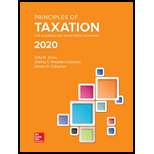
Principles Of Taxation For Business And Investment Planning 2020 Edition
23rd Edition
ISBN: 9781259969546
Author: Sally Jones, Shelley C. Rhoades-Catanach, Sandra R Callaghan
Publisher: McGraw-Hill Education
expand_more
expand_more
format_list_bulleted
Question
Chapter 13, Problem 27AP
a.
To determine
Calculate Incorporation D’s allowable dividends-received deduction with respect to each dividend.
b.
To determine
Calculate Incorporation D’s net dividend income.
Expert Solution & Answer
Want to see the full answer?
Check out a sample textbook solution
Students have asked these similar questions
I need assistance with this general accounting question using appropriate principles.
Please explain the solution to this general accounting problem with accurate explanations.
What is the operating leverage ?
Chapter 13 Solutions
Principles Of Taxation For Business And Investment Planning 2020 Edition
Ch. 13 - Why does a corporations state income tax cost...Ch. 13 - Prob. 2QPDCh. 13 - Prob. 3QPDCh. 13 - Prob. 4QPDCh. 13 - Borden Inc. conducts a business that spans four...Ch. 13 - Prob. 6QPDCh. 13 - Prob. 7QPDCh. 13 - Prob. 8QPDCh. 13 - Prob. 9QPDCh. 13 - Prob. 10QPD
Ch. 13 - Prob. 11QPDCh. 13 - Prob. 12QPDCh. 13 - Prob. 13QPDCh. 13 - Prob. 14QPDCh. 13 - Prob. 15QPDCh. 13 - Prob. 16QPDCh. 13 - This year, Mesa Inc.s before-tax income was...Ch. 13 - Prob. 2APCh. 13 - Prob. 3APCh. 13 - Prob. 4APCh. 13 - Prob. 5APCh. 13 - Prob. 6APCh. 13 - Prob. 7APCh. 13 - Prob. 8APCh. 13 - Prob. 9APCh. 13 - Prob. 10APCh. 13 - Prob. 11APCh. 13 - Prob. 12APCh. 13 - Prob. 13APCh. 13 - Prob. 14APCh. 13 - Prob. 15APCh. 13 - Prob. 16APCh. 13 - Prob. 17APCh. 13 - Prob. 18APCh. 13 - Prob. 19APCh. 13 - Prob. 20APCh. 13 - Prob. 21APCh. 13 - Prob. 22APCh. 13 - Prob. 23APCh. 13 - Prob. 24APCh. 13 - Prob. 25APCh. 13 - Prob. 26APCh. 13 - Prob. 27APCh. 13 - Prob. 28APCh. 13 - Prob. 29APCh. 13 - Prob. 30APCh. 13 - Prob. 31APCh. 13 - Prob. 32APCh. 13 - Prob. 33APCh. 13 - Prob. 34APCh. 13 - Prob. 35APCh. 13 - Prob. 36APCh. 13 - Prob. 37APCh. 13 - State E wants to encourage the development of a...Ch. 13 - Prob. 2IRPCh. 13 - Prob. 3IRPCh. 13 - Prob. 4IRPCh. 13 - Prob. 5IRPCh. 13 - Prob. 6IRPCh. 13 - Prob. 7IRPCh. 13 - Prob. 8IRPCh. 13 - Prob. 9IRPCh. 13 - Prob. 10IRPCh. 13 - Prob. 11IRPCh. 13 - Prob. 2RPCh. 13 - Prob. 3RPCh. 13 - Prob. 1TPCCh. 13 - Prob. 2TPCCh. 13 - Prob. 3TPCCh. 13 - Prob. 1CPCh. 13 - Prob. 2CP
Knowledge Booster
Similar questions
- I need help finding the correct solution to this financial accounting problem with valid methods.arrow_forwardPlease provide the solution to this general accounting question using proper accounting principles.arrow_forwardBradford Enterprises sells two products, blue pens and green notebooks. Bradford predicts that it will sell 3,200 blue pens and 900 green notebooks in the next period. The unit contribution margins for blue pens and green notebooks are $2.80 and $4.20, respectively. What is the weighted average unit contribution margin?arrow_forward
- I want the correct answer with accounting questionarrow_forwardI need the correct answer to this financial accounting problem using the standard accounting approacharrow_forwardAssume that 800 units were worked on during a period in which a total of 700 good units were completed. Normal spoilage consisted of 50 units; abnormal spoilage, 40 units. Total production costs were $3,600. The company accounts for abnormal spoilage separately on the income statement as a loss due to abnormal spoilage. Normal spoilage is not accounted for separately. What is the cost of the good units produced?arrow_forward
arrow_back_ios
SEE MORE QUESTIONS
arrow_forward_ios
Recommended textbooks for you


